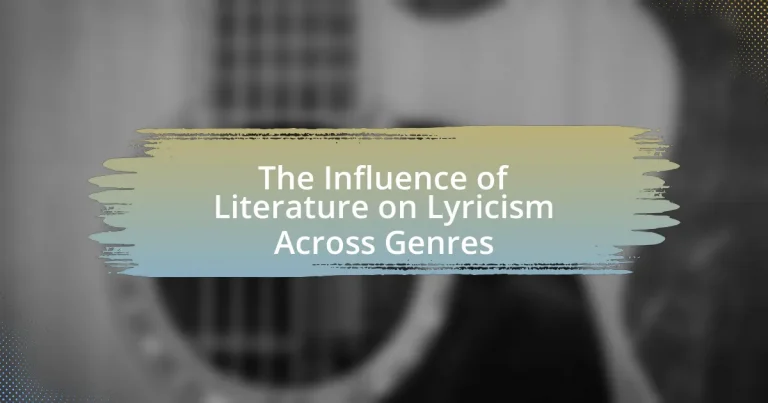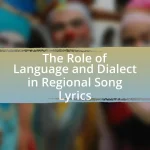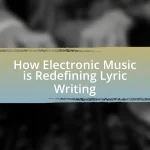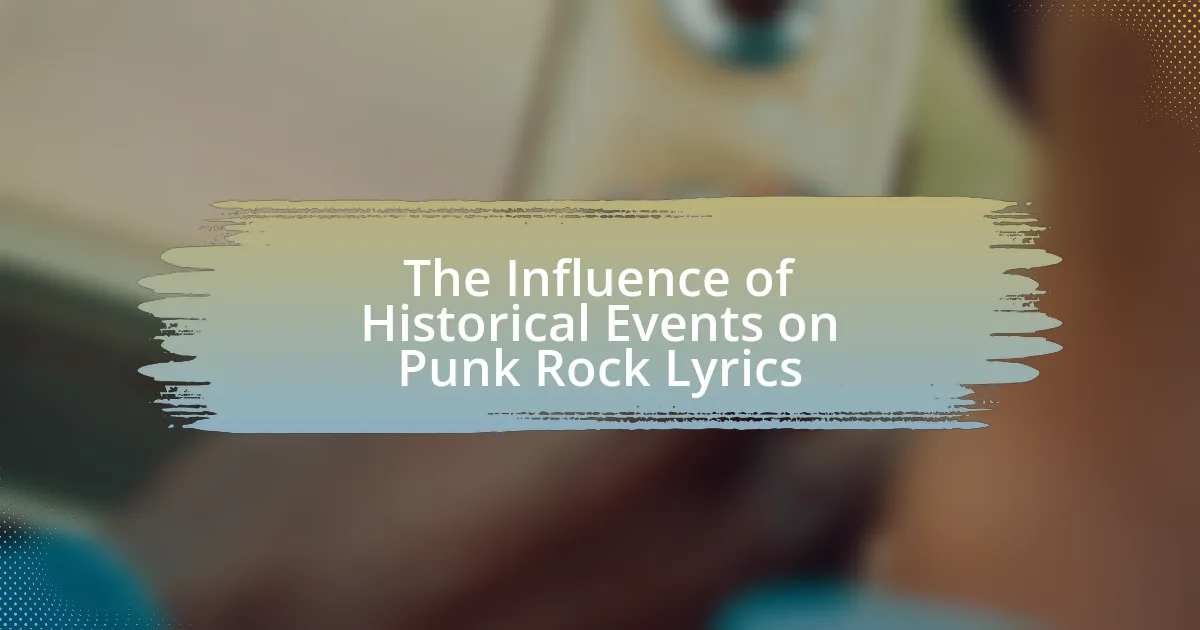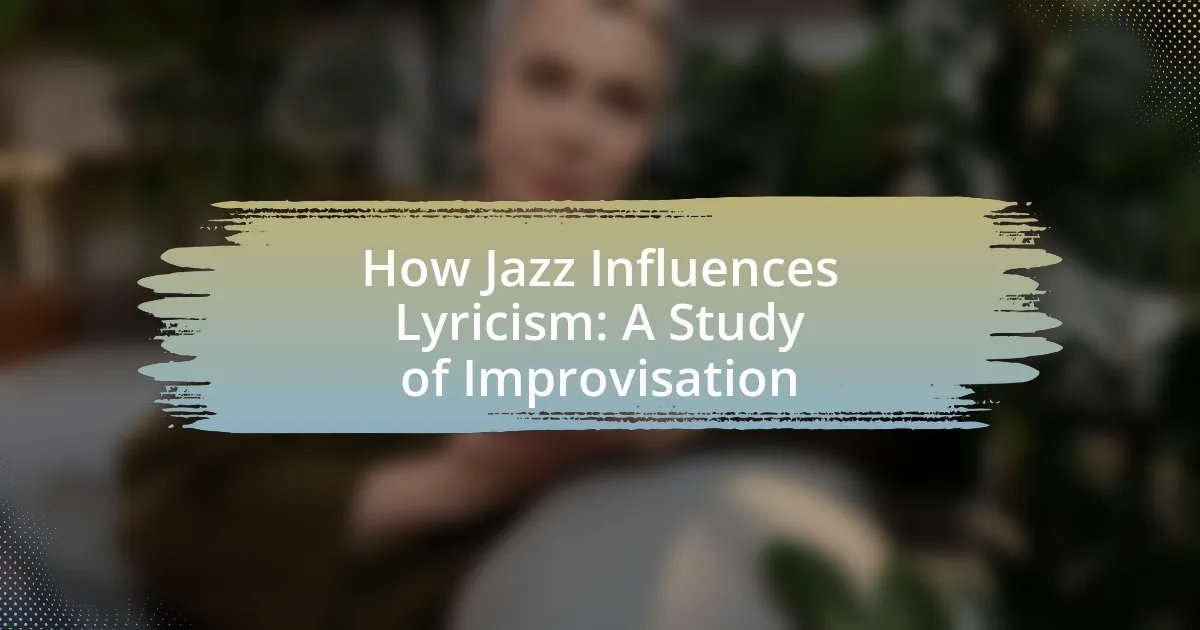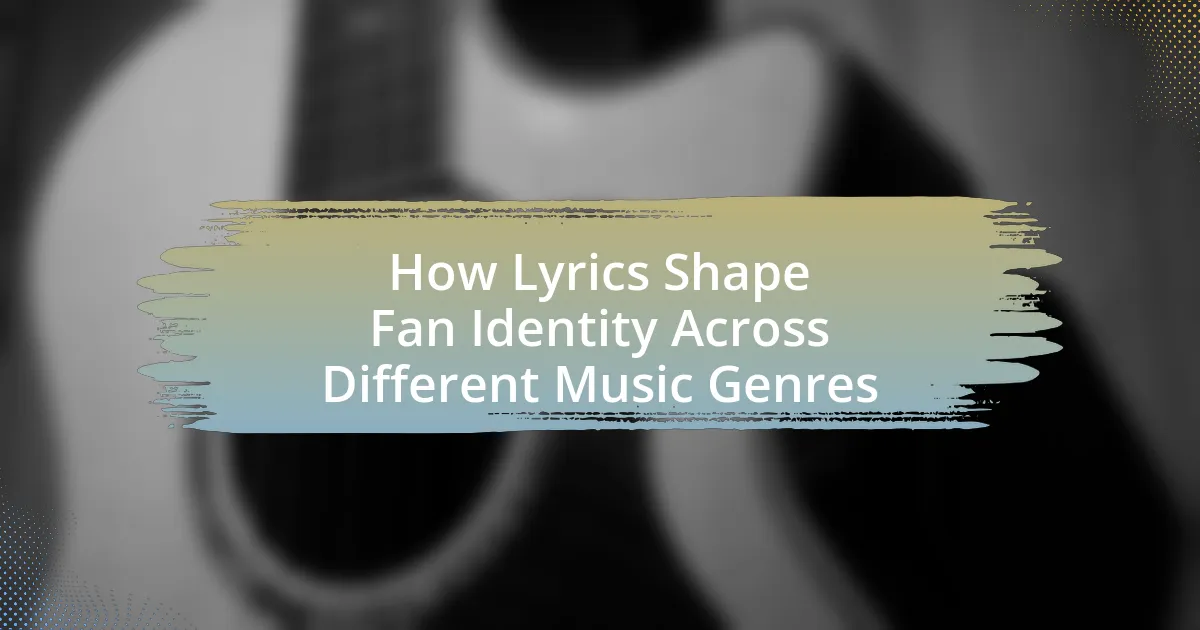The article examines the influence of literature on lyricism across various musical genres, highlighting how literary techniques and themes enrich song lyrics. It discusses the impact of renowned poets on modern songwriting, the use of literary devices such as metaphor and imagery, and the narrative structures that shape song composition. Additionally, the article explores the significance of historical and cultural contexts in understanding the relationship between literature and lyricism, as well as practical tips for aspiring lyricists to incorporate literary influences into their work. Key examples from artists in genres like hip-hop, rock, and pop illustrate the profound connection between literary expression and musical creativity.
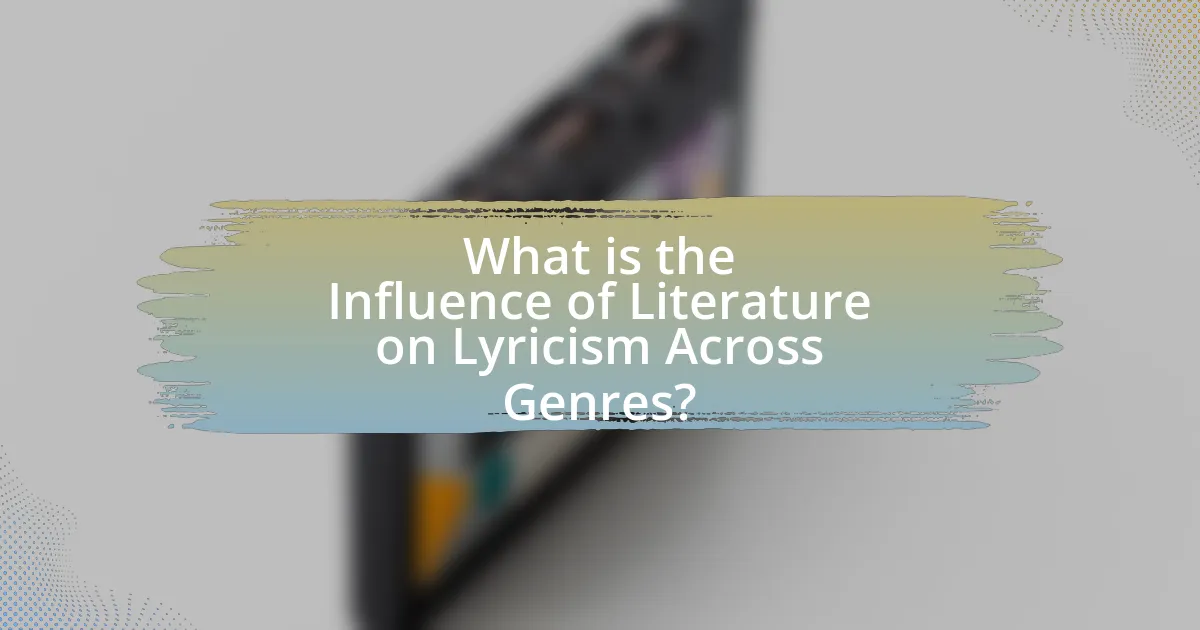
What is the Influence of Literature on Lyricism Across Genres?
Literature significantly influences lyricism across genres by providing thematic depth, narrative structure, and rich imagery. For instance, poets like T.S. Eliot and Robert Frost have shaped modern songwriting through their use of metaphor and symbolism, which can be seen in the works of contemporary artists such as Bob Dylan and Leonard Cohen. Additionally, literary techniques such as alliteration and enjambment enhance the musicality of lyrics, making them more engaging. The interplay between literary forms and lyrical expression is evident in genres like hip-hop, where artists like Kendrick Lamar draw on literary devices to convey complex social narratives, reflecting the profound impact of literature on the evolution of lyricism.
How does literature shape the themes in lyricism?
Literature shapes the themes in lyricism by providing rich narratives, emotional depth, and cultural context that lyricists draw upon. For instance, poets like William Wordsworth and Emily Dickinson have influenced modern songwriters by exploring themes of nature, love, and existential reflection, which are prevalent in contemporary lyrics. Additionally, literary devices such as metaphor, imagery, and symbolism found in literature enhance the lyrical quality, allowing artists to convey complex emotions and ideas succinctly. The interplay between literary themes and lyrical content is evident in genres like hip-hop, where artists often reference literary works to deepen their messages, as seen in the lyrics of artists like Kendrick Lamar, who incorporates elements of classic literature to address social issues.
What literary devices are commonly reflected in lyrics?
Common literary devices reflected in lyrics include metaphor, simile, alliteration, imagery, and personification. Metaphor and simile create vivid comparisons, enhancing emotional resonance; for example, Bob Dylan’s use of metaphor in “Blowin’ in the Wind” deepens the song’s thematic impact. Alliteration contributes to the musicality of lyrics, as seen in the repeated consonant sounds in Eminem’s verses. Imagery evokes sensory experiences, allowing listeners to visualize scenes, such as in Taylor Swift’s storytelling. Personification attributes human qualities to non-human elements, enriching the narrative, as demonstrated in many of The Beatles’ songs. These devices collectively enhance the lyrical quality and emotional depth, illustrating the strong connection between literature and lyricism.
How do narrative techniques from literature influence song structure?
Narrative techniques from literature significantly influence song structure by providing frameworks for storytelling, character development, and thematic exploration. For instance, the use of a clear narrative arc, including exposition, rising action, climax, and resolution, mirrors the structure of many songs, allowing artists to convey complex emotions and stories within a limited time. Additionally, literary devices such as imagery, symbolism, and metaphor enhance lyrical depth, making songs more relatable and impactful. A notable example is Bob Dylan’s “Tangled Up in Blue,” which employs shifting perspectives and nonlinear storytelling, akin to literary narratives, to create a rich, immersive experience. This blending of literary techniques into songwriting not only enriches the lyrics but also engages listeners on multiple levels, demonstrating the profound connection between literature and music.
Why is the relationship between literature and lyricism significant?
The relationship between literature and lyricism is significant because both forms of expression share a deep connection in their exploration of human emotions and experiences. Literature often provides the narrative depth and thematic richness that lyricism draws upon, allowing songwriters and poets to convey complex feelings and stories in a condensed format. For instance, many song lyrics are influenced by literary works, as seen in the music of artists like Bob Dylan, whose lyrics reflect the storytelling techniques found in novels and poetry. This interplay enhances the emotional resonance of both mediums, making them powerful tools for communication and cultural reflection.
What historical contexts highlight this relationship?
The historical contexts that highlight the relationship between literature and lyricism across genres include the Romantic period, which emphasized emotional expression and individualism in both poetry and song lyrics. During this time, poets like William Wordsworth and John Keats influenced lyricists by prioritizing personal experience and nature, leading to a blending of poetic techniques in music. Additionally, the Harlem Renaissance showcased the interplay between African American literature and music, with figures like Langston Hughes inspiring jazz and blues lyricists, thereby enriching the lyrical content with themes of identity and social justice. These contexts demonstrate how literary movements have shaped the evolution of lyricism, providing a foundation for thematic and stylistic developments in various musical genres.
How do cultural movements in literature impact lyrical content?
Cultural movements in literature significantly shape lyrical content by influencing themes, language, and stylistic choices. For instance, the Romantic movement emphasized emotion and nature, leading to lyrics that reflect personal feelings and the beauty of the natural world. Similarly, the Beat Generation introduced themes of rebellion and existentialism, which can be seen in the raw, candid expressions found in the lyrics of artists like Bob Dylan and Allen Ginsberg. Historical context also plays a role; during the Civil Rights Movement, lyrics often addressed social justice and equality, as evidenced in songs by artists like Nina Simone and Sam Cooke. These examples illustrate how literary movements not only inspire lyrical themes but also affect the overall tone and structure of lyrics across various musical genres.
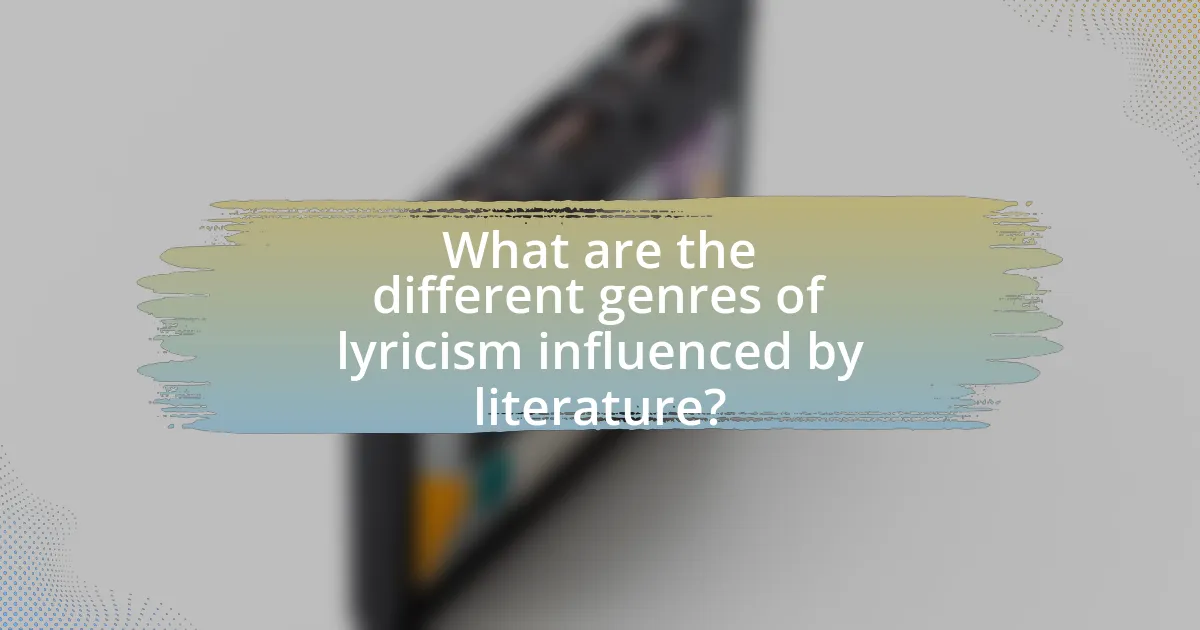
What are the different genres of lyricism influenced by literature?
Different genres of lyricism influenced by literature include narrative poetry, ballads, sonnets, and spoken word. Narrative poetry tells a story, often incorporating elements of fiction and character development, as seen in works like “The Raven” by Edgar Allan Poe. Ballads, which are often set to music, convey emotional tales and have roots in folk traditions, exemplified by “Barbara Allen.” Sonnets, particularly those from the Renaissance, explore themes of love and beauty, with Shakespeare’s sonnets being a prime example. Spoken word combines performance with poetic expression, drawing from literary techniques to engage audiences, as demonstrated in the works of poets like Sarah Kay. Each genre reflects literary influences through structure, themes, and stylistic choices.
How does poetry influence hip-hop lyricism?
Poetry significantly influences hip-hop lyricism by providing a rich framework of rhythm, metaphor, and emotional expression. Hip-hop artists often draw from poetic devices such as alliteration, assonance, and imagery to enhance their lyrical depth and storytelling. For instance, the use of enjambment in poetry mirrors the flow of hip-hop verses, allowing for seamless transitions and complex narratives. Additionally, many hip-hop artists, like Nas and Kendrick Lamar, explicitly reference poetic influences in their work, showcasing how literary techniques elevate their messages and connect with audiences on a deeper level. This interplay between poetry and hip-hop not only enriches the genre but also highlights the cultural significance of both forms of expression.
What poetic forms are prevalent in hip-hop lyrics?
Hip-hop lyrics predominantly feature poetic forms such as rhyme schemes, alliteration, assonance, and metaphor. Rhyme schemes, particularly end rhymes and internal rhymes, create rhythm and enhance memorability, which is essential in hip-hop. Alliteration and assonance contribute to the musicality of the lyrics, making them more engaging. Metaphors are frequently used to convey complex emotions and social commentary, allowing artists to express deeper meanings within their verses. These forms are integral to the genre, as they not only showcase lyrical skill but also connect with the rich tradition of oral storytelling and poetry.
How do hip-hop artists draw from literary themes?
Hip-hop artists draw from literary themes by incorporating narrative techniques, character development, and poetic devices into their lyrics. For instance, many hip-hop songs tell stories that reflect personal experiences or societal issues, similar to narrative structures found in novels. Artists like Nas in “Illmatic” utilize vivid imagery and metaphor, akin to literary works, to convey complex emotions and social commentary. Additionally, the use of alliteration, rhyme schemes, and rhythm in hip-hop parallels the stylistic elements of poetry, enhancing the lyrical depth and engagement. This blending of literary techniques not only enriches the music but also connects hip-hop to broader cultural and artistic movements, demonstrating its literary significance.
In what ways does literature influence rock and pop lyrics?
Literature influences rock and pop lyrics through thematic exploration, narrative techniques, and poetic devices. Many songwriters draw inspiration from literary works, using themes such as love, loss, and existentialism that are prevalent in both literature and music. For example, Bob Dylan’s lyrics often reflect the influence of poets like Walt Whitman and T.S. Eliot, incorporating complex imagery and social commentary. Additionally, the storytelling aspect of literature is mirrored in songs that convey a narrative arc, as seen in tracks like “The River” by Bruce Springsteen, which tells a poignant story akin to a short story or novel. Furthermore, the use of metaphor, symbolism, and alliteration in literature enhances the lyrical quality of songs, making them more evocative and memorable, as demonstrated in the works of artists like Leonard Cohen and Joni Mitchell.
What are common literary references found in rock lyrics?
Common literary references found in rock lyrics include allusions to classic literature, poetry, and historical figures. For instance, Bob Dylan frequently references works by authors such as Homer and Shakespeare, while songs like “The Wasteland” by T.S. Eliot have inspired bands like Pink Floyd. Additionally, the use of biblical references is prevalent, as seen in songs like “The River” by Bruce Springsteen, which draws on themes from the Book of Exodus. These references enrich the lyrics, providing deeper meaning and connecting the music to broader cultural and literary contexts.
How do pop lyrics utilize storytelling techniques from literature?
Pop lyrics utilize storytelling techniques from literature by employing narrative structures, character development, and thematic elements. For instance, many pop songs follow a clear narrative arc, similar to short stories, where a beginning introduces a conflict, a middle explores the tension, and an end resolves the situation. Artists like Taylor Swift and Ed Sheeran often create relatable characters and scenarios that resonate with listeners, mirroring the character-driven plots found in novels. Additionally, pop lyrics frequently incorporate universal themes such as love, loss, and identity, akin to literary works, which enhances emotional engagement. This blending of literary techniques with musical expression allows pop songs to convey complex stories in a concise format, making them impactful and memorable.
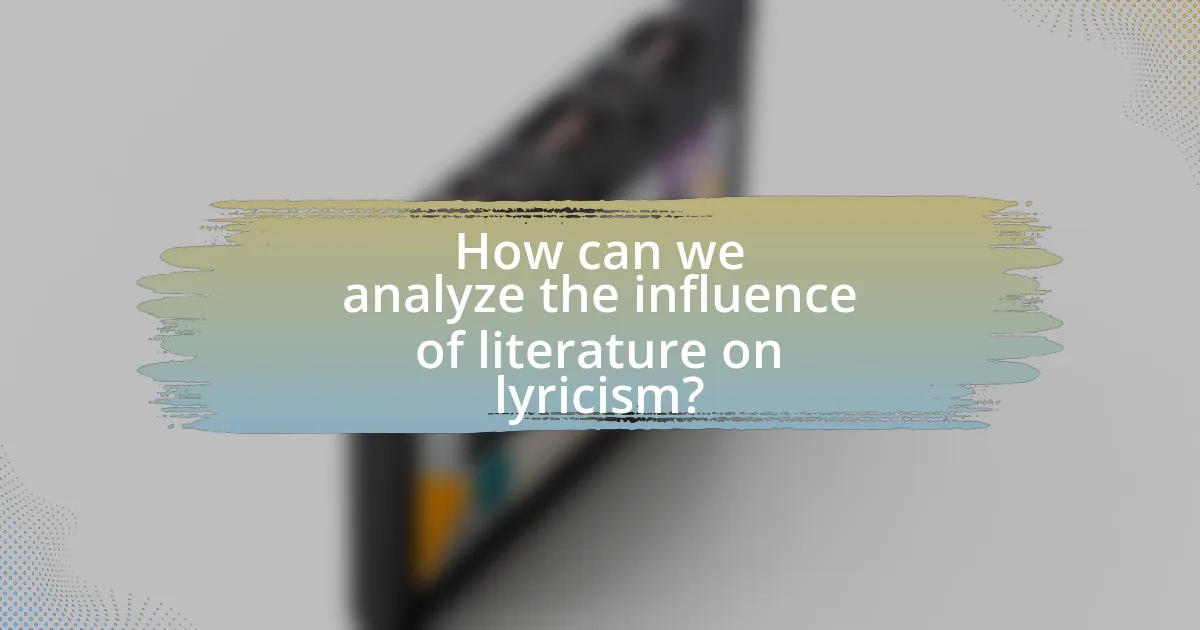
How can we analyze the influence of literature on lyricism?
Analyzing the influence of literature on lyricism involves examining the thematic, structural, and stylistic elements that literature imparts to song lyrics. Literary devices such as metaphor, imagery, and narrative techniques are often mirrored in lyricism, enhancing emotional depth and storytelling. For instance, the use of alliteration and rhyme in poetry can be found in various musical genres, demonstrating a direct correlation between literary forms and lyrical composition. Historical examples include the works of poets like Walt Whitman and their impact on folk music, where their narrative style and vivid imagery resonate in the lyrics of artists like Bob Dylan. This connection illustrates how literary traditions shape the evolution of lyricism across genres, providing a framework for analysis that highlights the interplay between written and musical expression.
What methods are effective for analyzing lyrical content?
Effective methods for analyzing lyrical content include thematic analysis, linguistic analysis, and sentiment analysis. Thematic analysis involves identifying and interpreting themes within lyrics, allowing for a deeper understanding of the underlying messages and cultural contexts. Linguistic analysis examines the language, structure, and stylistic devices used in lyrics, which can reveal the artist’s intent and influence from literary traditions. Sentiment analysis utilizes computational techniques to assess the emotional tone of lyrics, providing insights into the emotional landscape conveyed by the artist. These methods are supported by research in musicology and literary studies, demonstrating their validity in understanding the interplay between literature and lyricism across genres.
How can literary analysis enhance our understanding of lyrics?
Literary analysis enhances our understanding of lyrics by providing tools to interpret themes, symbols, and narrative structures within the text. By examining the use of literary devices such as metaphor, imagery, and allusion, listeners can uncover deeper meanings and emotional resonances in the lyrics. For instance, analyzing Bob Dylan’s use of symbolism in songs like “Blowin’ in the Wind” reveals social and political commentary that may not be immediately apparent. This analytical approach allows for a richer appreciation of the artistry involved in songwriting, as it connects lyrical content to broader literary traditions and cultural contexts.
What role does context play in interpreting lyrics influenced by literature?
Context plays a crucial role in interpreting lyrics influenced by literature, as it shapes the meaning and emotional resonance of the words. The historical, cultural, and personal background of both the lyricist and the audience informs how the lyrics are understood. For instance, a lyric referencing a specific literary work may evoke different interpretations depending on the listener’s familiarity with that text, its themes, and the societal issues it addresses. Research indicates that context can significantly alter the perception of artistic expressions; for example, a study by Bruner (1990) in “Acts of Meaning” highlights how context influences cognitive processes in understanding narratives. Thus, the interplay between context and literary influence is essential for a comprehensive interpretation of lyrics.
What are some practical tips for aspiring lyricists to incorporate literary influences?
Aspiring lyricists can incorporate literary influences by reading a diverse range of literature, analyzing poetic devices, and experimenting with narrative techniques. Engaging with various genres, such as poetry, novels, and plays, exposes lyricists to different styles and themes, enhancing their lyrical vocabulary and depth. For instance, studying the works of poets like Sylvia Plath or Robert Frost can provide insights into imagery and metaphor, which are essential in songwriting. Additionally, lyricists can practice writing in different forms, such as sonnets or free verse, to develop their unique voice and structure. This approach is supported by the fact that many successful songwriters, like Bob Dylan and Leonard Cohen, have drawn heavily from literary sources, demonstrating the effectiveness of this method in creating impactful lyrics.
How can reading literature improve lyrical writing skills?
Reading literature enhances lyrical writing skills by exposing writers to diverse styles, themes, and vocabulary. This exposure allows lyricists to understand narrative structures and emotional depth, which are crucial for crafting compelling lyrics. For instance, studying poetry and prose can improve a writer’s ability to use imagery and metaphor effectively, as demonstrated by the works of authors like Sylvia Plath and F. Scott Fitzgerald, whose rich language and emotional resonance can inspire lyrical creativity. Additionally, literature often explores complex human experiences, providing lyricists with a broader emotional palette to draw from, ultimately enriching their songwriting.
What exercises can help lyricists draw inspiration from literary works?
Lyricists can draw inspiration from literary works through exercises such as close reading, creative reinterpretation, and thematic exploration. Close reading involves analyzing a specific poem or prose piece to identify its themes, imagery, and emotional resonance, which can then be translated into lyrical content. Creative reinterpretation encourages lyricists to take a literary work and rewrite it in their own voice or style, fostering originality while maintaining the essence of the source material. Thematic exploration allows lyricists to identify universal themes in literature, such as love, loss, or identity, and use these themes as a foundation for their lyrics, enhancing relatability and depth. These exercises are effective as they engage the lyricist’s analytical and creative faculties, leading to richer lyrical compositions.
